Development and evaluation of inexpensive automated deep learning-based imaging systems for embryology†
Abstract
Embryo assessment and selection is a critical step in an in vitro fertilization (IVF) procedure. Current embryo assessment approaches such as manual microscopy analysis done by embryologists or semi-automated time-lapse imaging systems are highly subjective, time-consuming, or expensive. Availability of cost-effective and easy-to-use hardware and software for embryo image data acquisition and analysis can significantly empower embryologists towards more efficient clinical decisions both in resource-limited and resource-rich settings. Here, we report the development of two inexpensive (<$100 and <$5) and automated imaging platforms that utilize advances in artificial intelligence (AI) for rapid, reliable, and accurate evaluations of embryo morphological qualities. Using a layered learning approach, we have shown that network models pre-trained with high quality embryo image data can be re-trained using data recorded on such low-cost, portable optical systems for embryo assessment and classification when relatively low-resolution image data are used. Using two test sets of 272 and 319 embryo images recorded on the reported stand-alone and smartphone optical systems, we were able to classify embryos based on their cell morphology with >90% accuracy.



 Please wait while we load your content...
Please wait while we load your content...